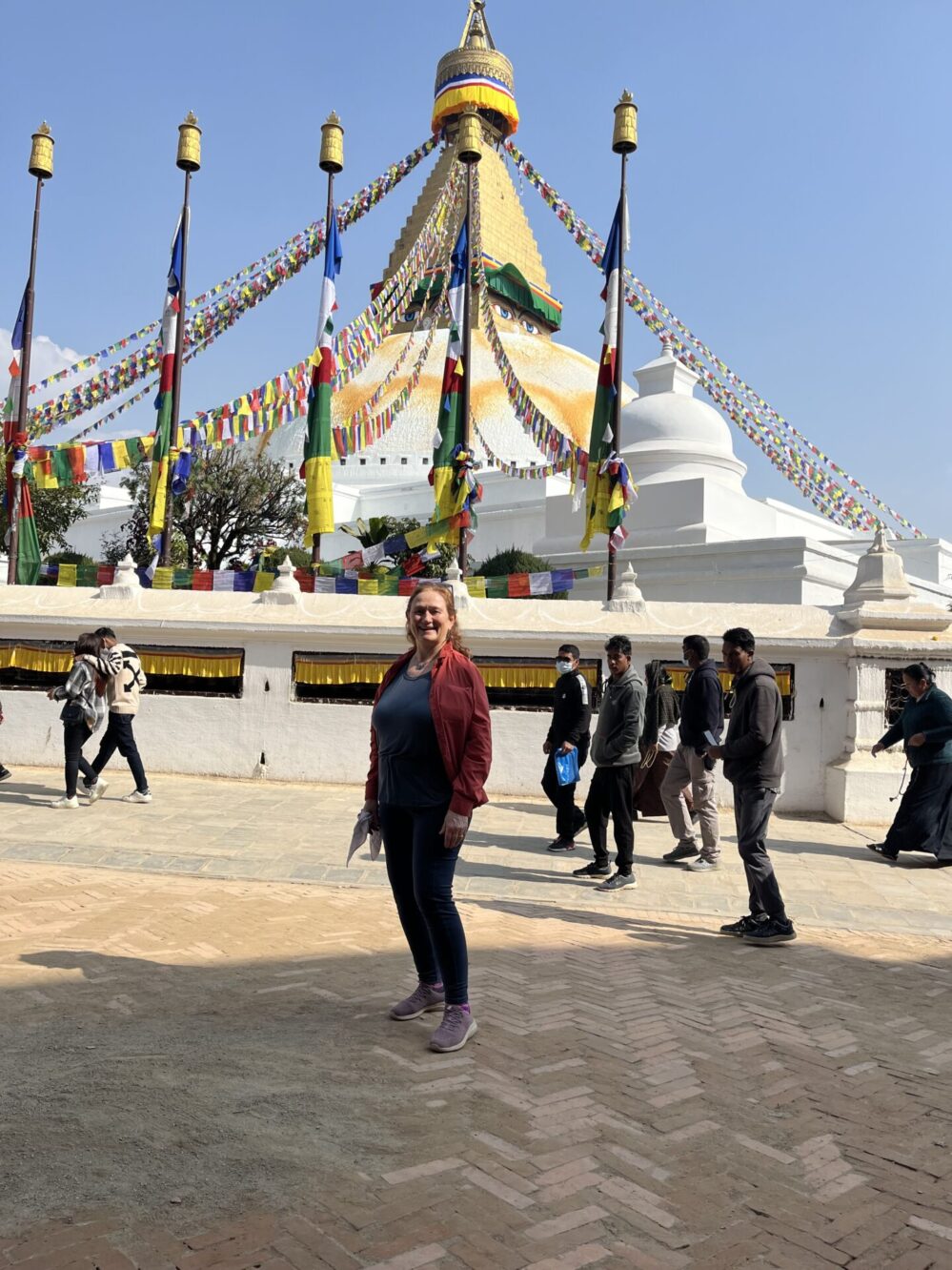
Special Correspondent Tam Agosti-Gisler just returned from an extended visit to Nepal. Previously, she’s contributed reports from Mexico’s Yucatan Peninsula and Cordova, Alaska. This is her report.
VISITING NEPAL
I spent two weeks in Nepal and have some suggestions for anyone interested in visiting that country.
VISA
Do the Nepalese visa application on-line in advance and print it out. When you arrive at the airport in Kathmandu, go to a booth to pay the $30 US fee and then to immigration with the payment receipt, the application form, and your passport. It’s actually quite efficient.
TOURING IN KATHMANDU
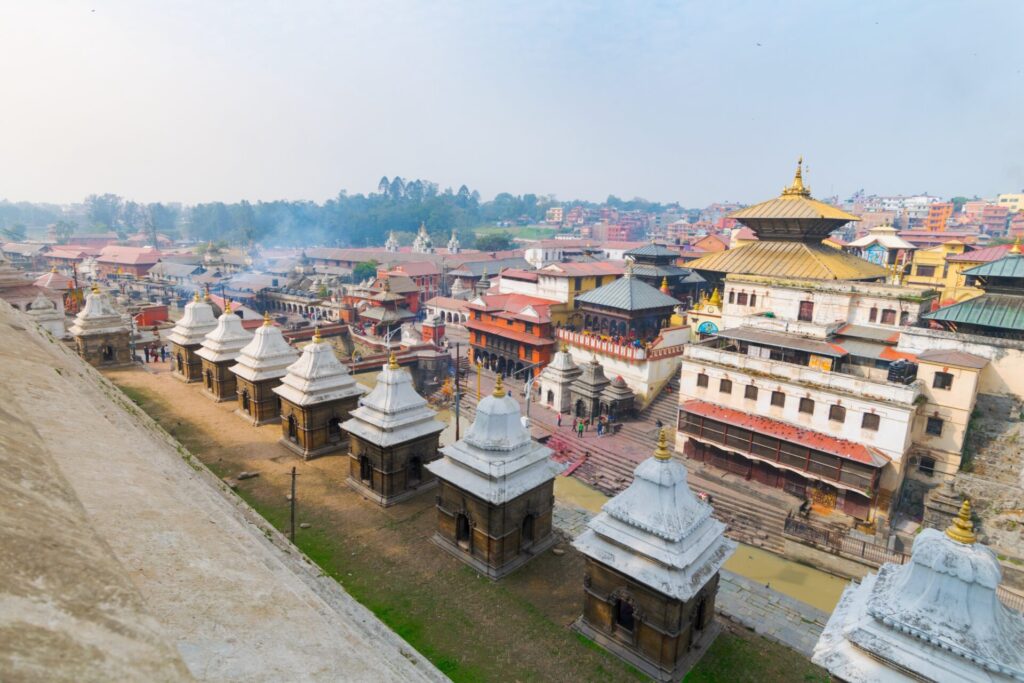
There are some offers on Trip Advisor for touring the city and seeing UNESCO-designated cultural heritage sites. Or you can book through your hotel as I did. The top four on my list included: Pashupati Nath Temple – the oldest Hindu temple in the world dedicated to Shiva. Many Indian tourists were also there to make offerings. My driver told me I had to take my shoes off to go into the compound and I was horrified to walk around in my stocking feet on the rock and dirt! My guide told me that was only for Hindus and let me put them back on! I wasn’t allowed in the temple but was able to observe the rituals that take place behind it in on the banks of the river. There were several cremations taking place and my guide explained their rituals and belief system about returning the body to the earth. All around gurus and Brahmin priests could be seen as well as monkeys!

Next, we headed to the largest Buddhist stupa in the world called BoudhaNath, a pilgrimage site that needed to be rebuilt after the 8.4 earthquake in 2015. Buddhists filled the square lighting incense, turning prayer wheels, and performing kora or clockwise strolls around the monument. I enjoyed seeing the mandala art and listening to prayer bowl vibrations.
After a break for lunch, we drove to the Buddhist stupa called Swayambhu. I was reluctant to go until I learned it was at the top of a big mount giving views over the entire city. He drove me as high as a car was allowed and I huffed and puffed up the final steps. Kathmandu is a huge city of 1.4 million spread across the valley.

Next stop on my tour was to Durbar Palace Square, the UNESCO-listed heart of Kathmandu’s Old City. This vibrant public square was once the Kathmandu Kingdom royal residence and has a large concentration of well-preserved ancient buildings, making for a stunning architectural open-air museum.
3 DAY/2 NIGHT EXCURSION TO CHITWAN NATIONAL PARK
I highly recommend this adventure. I booked through my Rotarian friend’s company – Nepal Hiking. (NepalHiking.com) The $190 package included a tourist class bus ride from Kathmandu to the park and the return trip also. The bus ride took over 7 hours and allowed me to see some river valleys, but I recommend you pay the additional cost to fly from Kathmandu to Bharatpur which only takes 45 minutes and maybe take the bus back. I flew with Buddha Air which has multiple flights per day. Arranged with the company to have someone pick you up at the airport and take you the 30 minutes to the town of Sauraha (technically the adjoining village of Ratnanaga where the hotel is found. Safari Adventure Lodge next to Chitwan National Park is situated in the Terai Lowlands of south-central Nepal. This all-inclusive tour (hotel, meals, guide, transportation) was wonderful. My guide, Mahendra Chaudhary, met me and took me into the lobby where I was offered a warm hand washing towel and a welcome drink. He explained the itinerary for the two days and then led me to my room. The hotel is comfortable, and the grounds are beautiful. There is even a lovely swimming pool which I’m sure is used a lot in the summer when the temperatures reach 40 C/104 F! It is winter in January-February, so it is too chilly to swim! Most notably, it was nice to replace construction and traffic noise of the city with the sounds of birds singing! Meals are served buffet style in the dining room with three young men heaping lots of attention on you. I enjoyed a delicious lunch and then relaxed outside under one of the “palapas” until it was time for our jungle safari. Our group of 8 were offered the option of an elephant ride or a jeep ride, but in agreement with what many animal activists consider inhuman treatment of elephants for tourism, we all decided on the later. We all crawled up into an open-air jeep with an elevated platform on the back featuring four rows of seats. We were instructed to dress warmly which I did and, as the afternoon turned into evening, it was cold! The cold here is very damp, so it penetrates clothing. I’m glad I had three upper layers, a ski cap, and gloves. My legs were still very cold, but I never considered bringing long underwear to South Asia!! We traveled through the nearby town of Sauraha, and I noted there were about 50 different hotels and many shops; this is a major tourist destination in the country. I was even more appreciative of our quiet location on the outskirts! As we were crossing a one-lane bridge over the Rapti River, a local pointed out a python that was on the edge of the river! We were told there are over 50 types of poisonous snakes in this national park! I was glad we were riding up high and not walking!

We then entered the lovely Chitwan National Park, known for its biodiversity. For the next three hours we bumped over rough roads and paths and through the dense forests and grassy plains. There were numerous other jeeps with tourists and student groups, but our guide was adept at letting them speed past and waiting until the dust settled. We went at a slower pace which was great. We saw an amazing number of animals and our guide was quite proficient in providing the names: Elephants (those that are tamed and being ridden), Spotted deer, Hawk deer, Sambar deer, Gray Langur Monkeys, Wild Boar, Crocodiles, Turtle, and One-horned Asiatic Rhinoceroses! We were told there are about 500 rhinos in the park. Our guide gave us the names of the numerous birds: Ruddy Shell Duck (also called the Siberian Duck or Lovebird), Cormorant, Peacock, Lesser Adjutant Stork, Kingfisher, White-throated Kingfisher (or Bluebird), Red-vented Bulbul, Spitted Owlet, Greater Flame-back, Horned Buzzard, Chestnut-tailed Starling, Myna Bird, Rufous Treepie, and Little Egret. We never saw any of the estimated 125 Royal Bengal tigers in this park, but we did see some fresh tracks!
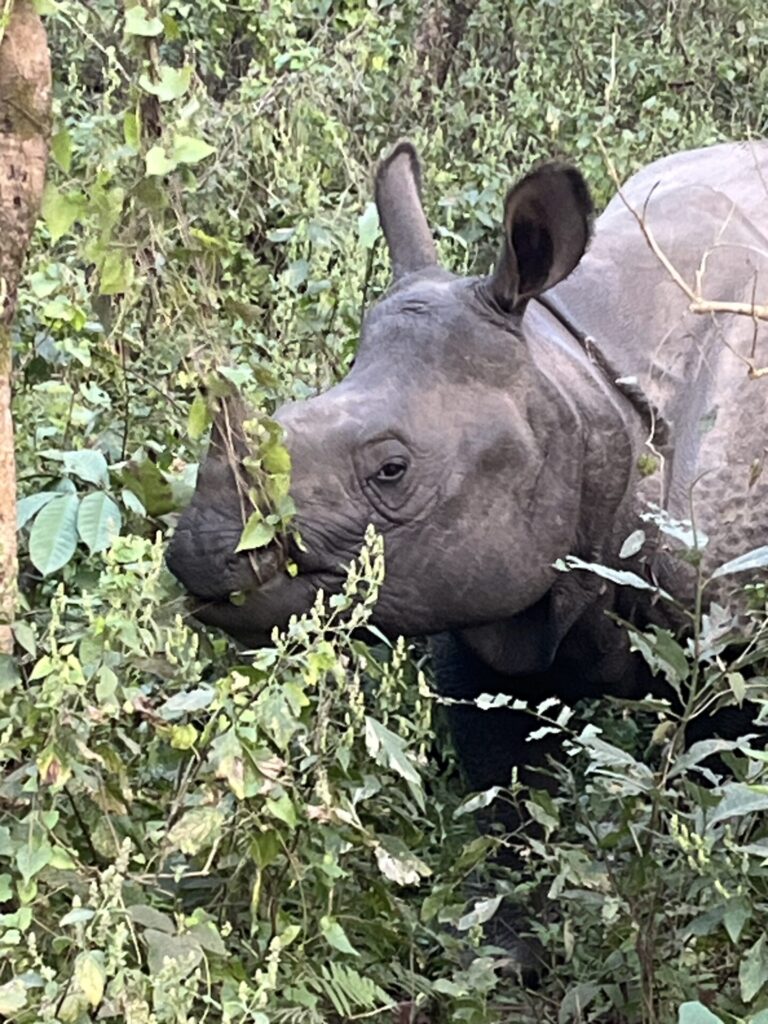
Our favorite animal spotting was when a rhino came bouncing out of the woods and stopped to graze not five feet from my side of the jeep! I was thrilled with the pictures and video I was able to capture. Later, as we were watching the sun set, a mother and baby rhino trotted by to entertain us.
We had a short break to warm up in our rooms with my heater set to high! Then were off again to the Tharu Cultural Show in town, riding in a normal bus. We watched a 45-minute dance and music show with traditional costumes from this indigenous group. The fire dance was quite impressive.
The next morning, another guest and I took a walk with our guide, Mahendra, around the area. Every morning it is cool and foggy, so we were again dressed appropriately. He is well versed in flora and fauna and pointed out and named trees and birds. One tree is called a rhino apple tree as it produces an apple-like fruit that the rhinos and deer like to eat. We had an impressive sight of the suspension footbridge over the Rapti River with the other end obscured by the fog. We stopped and tasted some locally produced honey, and I couldn’t resist buying some small jars because the taste was so unique and delicious.
Many free-roaming dogs joined us on our walk, and we were quite amused with one that looked a combo of a Husky and a Corgi! Suddenly the dogs gave chase and we saw them go after a jackal!
As we walked through the adjacent Tharu village, we kept snapping photos of the goats and their darling kids, some only 6 days old, water buffaloes, decorated homes, and locals at work (washing clothes in the river, combing a child’s hair, cleaning rice, etc.). Our guide took us to a small Tharu museum where we saw the traditional tools used in farming and food preparation. We saw a purple flower called Azaratum that was planted around some of the gardens. Our guide told us this was not an endemic plant, but one specifically brought here as it’s toxic to animals and therefore, stay out of the crops. We returned to our hotel after about 2 hours and were served fresh ginger tea.

Our afternoon excursion was a ride in a wooden dugout canoe! We took a minibus to a spot on the south side of the Rapti River and boarded I was a bit nervous, not being in a canoe, but because I didn’t know how the other passengers would behave. Any erratic movement would have tipped us in the water. We didn’t have lifejackets, but the water was only about 3-feet deep. It wasn’t just getting my phone and body wet that concerned me, it was that the river is filled with Marsh Mugger crocodiles that do indeed eat humans!!!

We saw many of them sunbathing on the shores as our boater steered us down the river with a long stick. Mahendra pointed out the crocodile and bird holes borne into the mud in the riverbanks as well as the dirt slides where the larger animals like rhinos and elephants come down to the river to drink. I breathed a sigh of relief when we deboarded close to the bridge I had seen earlier that morning. Then our guide announced we were going to WALK through the jungle and added “at our own risk.” He mentioned that tigers only attack from the back, so I decided to be right behind him and let the others follow me! They also talked about two wild elephants (one with the hilarious name of Ronaldo) in this forest and how if they got aggressive that we should run! My friend and looked at each other with apprehension. I told her that when people in Alaska ask what’s the best thing to carry for bears when hiking, we jokingly say “someone slower than yourself!” We figured the older couple on the excursion would be the slowest in an elephant attack!!
We hiked around the woods observing trees that were strangled by vines, jungle marshes, anthills, and lots more birds. We circled back to the river at the location of the elephant breeding center. They have tried using electric fences which were built around this area of the park so that they don’t have to keep the mothers and babies chained by their legs and could let them run free. However, two times the wild elephants have destroyed the fences. It is rather sad to see the elephants chained up, but we were told they do get daily breaks to be wander free in the forest to forage grass and to go the river to drink.
FLIGHTSEEING
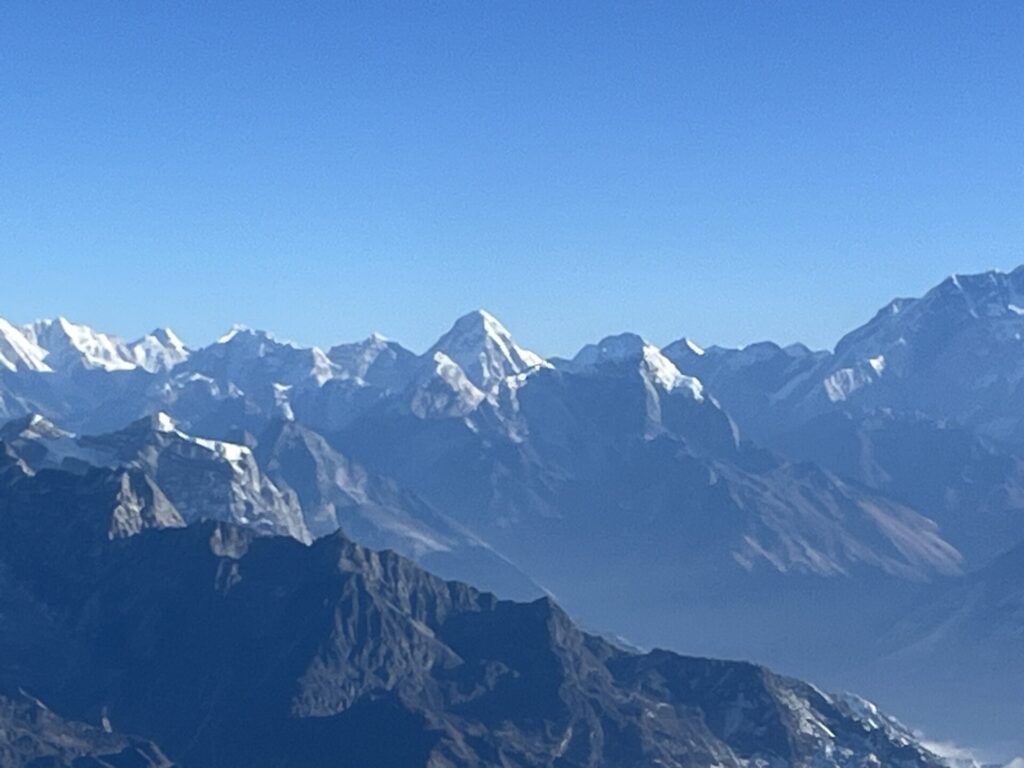
If you aren’t interested in paying a lot of money to fly to and stay at a base camp for Everest climbers, an alternative is a flightseeing tour. I booked a flightseeing through again through Nepal Hiking). The hotel driver took me to the domestic terminal at the airport where I checked in with Yeti Air. Our flight was scheduled for 6:25 am but didn’t leave until almost 7:00 am. There were a number of other tourists from Argentina, Wales, and India on the plane. We were each put in a window seat and given a map naming all of the peaks. On the way out, all of the mountains appeared on the left side and since I was on the right side, I was a bit frustrated as I had to look from the aisle seat to see anything. However, I soon discovered that when we reached the end of the Nepalese Himalayan Range, they turned the plane around and then my side had the best view. And since the fog had then lifted, I had sunny, clear views that were better than the other side had experienced! The flight attendants announced over the intercom which peaks we were seeing. We learned that one, called Gauri Shanker, is a sacred peak believed to be one of the homes of the Hindu god Shiva, and no climbers are allowed on it. I was, of course, thrilled to see Mt. Everest which is called Sagamarmatha in Nepali and means goddess of the sky. Towards the end of the flight, I, along with the other exhilarated passengers were each presented with a certificate from the pilot. The flight only lasted an hour, but I thought it was worth the price ($250), not unlike what we pay for flightseeing around our great mountain Denali in Alaska.
TREKKING (Hiking)
Winter is not the best time I was told because many of the paths are snow-covered. Many people go to Pokhara to do this as well as locations around the country for varying lengths. My Rotarian friend Tilak, his daughter Monika and I did a day hike from a town just outside of Kathmandu called Kiritpur. We started at Taudha (Snake Lake) where we made a circuit around the beautiful body of water after feeding food pellets to the many fish. I think they were wide-mouth bass and some looked like salmon! We then started our trek UP the mountain to the Campa Devi peak. During our climb, we encountered a traveling minstrel on the path who makes his living performing home to home. He played a song that Talik said was quite traditional and we all danced and laughed. We climbed farther with me panting all the way. At a temple dedicated to one of their many goddesses, we stopped to rest. The feet of the goddess are visible here. At the top of the mountain, I was told you find her head. We climbed a bit farther and the views of the valley and lake below were beautiful. We stopped to have a picnic lunch and then I told Tilak I could go no higher if I was to have enough knee and leg power to go back down! This was a strenuous climb for me, but for younger folks, probably not. The peak is at 4200 meters. We women began our descent via the village road and stationed ourselves at the Lemon Grass restaurant halfway down. It had a lovely balcony that offered expansive views of the valley. I enjoyed lemon tea with freshly sliced ginger and honey as well as spicy peanuts. Tilak eventually met up with us and after a break, we all descended the rest of the way to town. We made a stop at a shrine to the elephant god, Ganesh, and Tilak and Monika explained the story of how he got his elephant head.
TRADITIONAL NEWARI FOOD
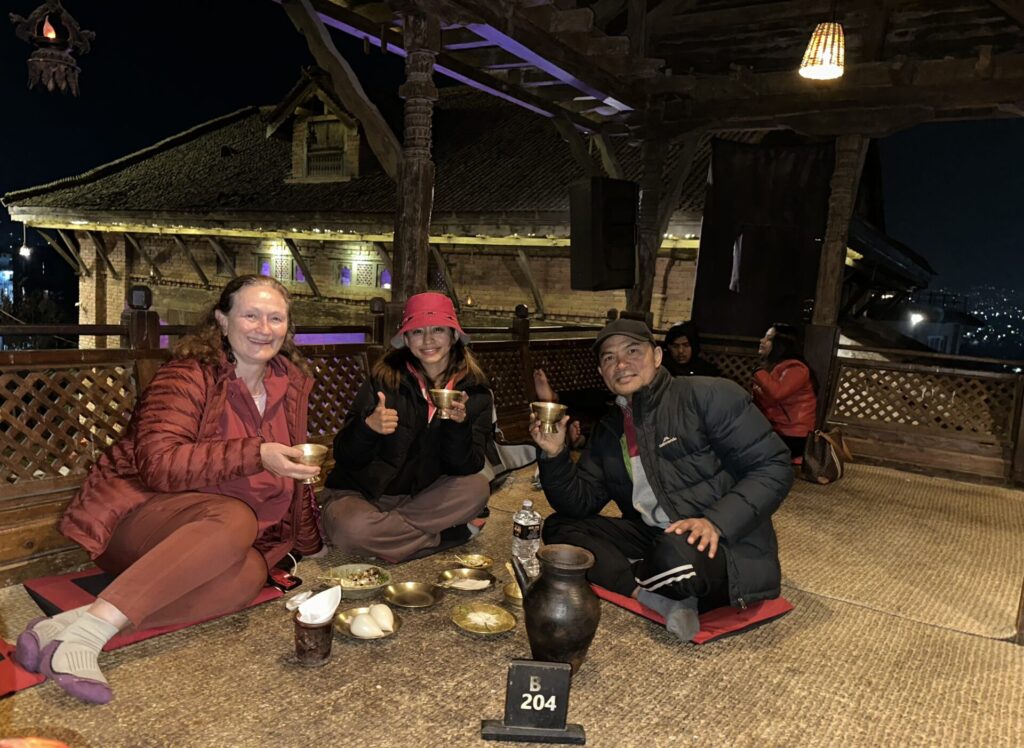
I recommend a visit to Sahde De Nawa restaurant in Kathmandu for a traditional Newari meal. As we entered, I noted it the beauty of this wooden building. We removed our shoes outside the open-air dining room and sat on mats on the straw floor to eat. Our dishes included: Samy Baji (beaten rice, black soybeans, ginger, boiled egg, black eye beans, spinach, and buffalo meat – a dish served at festivals and rituals said to bring luck, wealth, joy, good health, and long life); Mixed Chatamari (like a rice crepe with vegetable and egg) and Egg Bara (lentil pancake called the Newari “pizza”). We drank Chhaang (also called Thon), a rice-based slightly alcoholic drink, that is skillfully poured into special cups from a jug from about three feet/one meter above! For dessert, we had two types of Yomari, one with a sweet cottage cheese filling and the other with a jaggery taffy that I thought tasted like a fig paste.
TRAFFIC
Do not plan to drive at all in Nepal. The traffic is insane and traffic rules are hard to understand. They drive on the left side of the road but even that is flexible! Just riding in a taxi will provide enough excitement as a top-ranked roller coaster ride.
Share this Post

